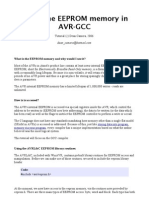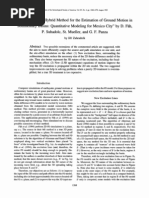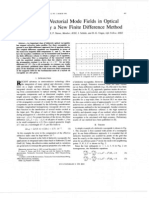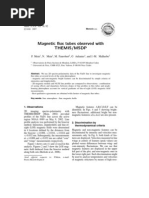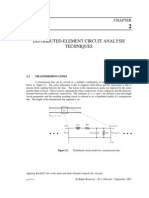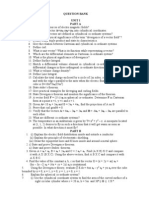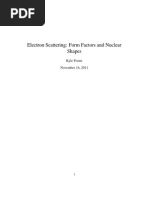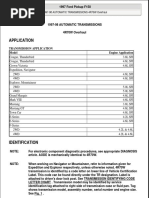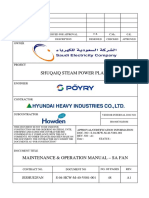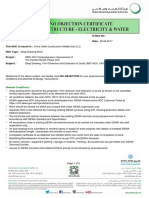And TM-Waves in Waveguides General Cross Section": November
And TM-Waves in Waveguides General Cross Section": November
Uploaded by
వేలుసామి లింగాసామిCopyright:
Available Formats
And TM-Waves in Waveguides General Cross Section": November
And TM-Waves in Waveguides General Cross Section": November
Uploaded by
వేలుసామి లింగాసామిOriginal Title
Copyright
Available Formats
Share this document
Did you find this document useful?
Is this content inappropriate?
Copyright:
Available Formats
And TM-Waves in Waveguides General Cross Section": November
And TM-Waves in Waveguides General Cross Section": November
Uploaded by
వేలుసామి లింగాసామిCopyright:
Available Formats
1436
PROCEEDINGS IEEE OF THE
November
TE- and T M - W a v e s in Waveguides of
Very General Cross Section
an alternative, the corresponding pattern can be measuredby using an electrolytic tank. In the latter case two models of identical shape corresponding to the cross section in questionareto be measured. These models differ in thatthe conducting and insulating walls are interchanged thus allowing for measurement of field and equipotential lines. Fig. l ( a ) shows the INTRODUCTION familiar curved field line and equipotential line pattern ITHINthelast decade, the desire for more of two charge line particles. Fig. l(b) shows the corresuitable waveguide shapes for meeting the new spondingstraight line pattern into which thecurved application requirements has often been prelines of Fig. l(a) can be transformed. If the Cartesian sented.Forexample,the problem of the high-power coordinatesxandyareinsertedinto Fig. l(b), then waveguide, the extremely low loss guide, and the most the vertical straight lines, x=const., correspond to the suitable guide for millimeter waves has not yet found a lines, x=const., inFig. l(a). In the same manner the final solution. I t is readily conceivable that the common equivalent to the horizontal straight lines, y =const., rectangularandcircular crosssections do not always in Fig. l(b) can be found in the curved lines, y=const., offer the optimum solution for meeting design requireof Fig. l(a). Each rectangle of Fig. l ( b ) which is ments.Thereforetheinvestigation of different modes bounded by lines, x=const. and y =const., corresponds in waveguides of arbitrary cross section will probably to the area bounded by the curved lines, x = const. and yield aclearpicture of wavebehaviorinwaveguides y = const., o f Fig. l(a). The large rectangle emphasized of general cross section, thus paving the way toward a in Fig. l(b) has the dimensions a . b and the origin of final solution to the above-mentioned problems. the Cartesian coordinates lies in the lower right corner This paper describes a simple method for calculating of thisrectangle.Thereforethisrectangle is bounded all modes in a waveguide of arbitrary cross section if the by the lines x=O, x = a , y=O and y = b in Fig. l(b). cross section in question can be transformed into a The corresponding area in Fig. l ( a ) is considered as the rectangle by conformal transformation. The conformal cross section to be investigated forthe purpose of setting mapping procedure thus enables the calculation of upthetheory.Thereforethebounding lines arethe critical frequencies, fields, wall currents, transported crosssection walls. Thiswaveguide crosssectionhas power and the attenuation of the various modes. beentransformed into the rectangle of Fig. l(b), and the line pattern of Fig. l(a) is the coordinatesystem CONFORMAL TRANSFORMATION OF THE GENERAL in which the wave field is to be calculated. CROSS SECTION If an elementary area d A bounded by the edges dx The coordinatepattern of a giventwo-dimensional and dy is considered [Fig. l(b)], this area corresponds conformal transformation (electrical field lines and to the conformal element dA* bounded by the edges equipotential lines of a plane electrostatic field) can be dx* and dy* [Fig. l(a)]. The fundamental law of conused in the following analysis. Many of these coorformaltransformation is dinatepatternscan beobtainedfrombooksdealing dz* = F(x, y)dx; dy* = F(x, y)dy. (1) with the subject of conformal trans for ma ti or^^^ or, as
Summary-The waveguide of the general cross section is transformed into a waveguide of rectangular cross section by conformal transformation.The electric and magnetic field, the critical frequency, wall current, power transport and attenuation of the different T E and TM-modes are calculated by a series approximation. Examples of numerical evaluation are given for five different cross sections.
* Received July 24, 1963.
f Technische Hochschule, Munich, %many. A. Betz. Konforme Abbildung, Springer-Verlag, Berlin,
Therefore both line elements are multiplied by the samefactor F , where F is position dependent in the general case. This function F can be calculated from F ( x , y)
= -= -
dx*
dy* dy
Ge&iny; 1961. 4 E. Weber, Electromagnetic fields, in Mapping of Fields, vol. 1, John \Viley and Sons, Inc., New York, N. Y.; 1950.
dx
in a pure analytical manner
if the transforming func-
1963
dleinke, et al.: TE- and l,lI-Waves Waveguides in
1437
(b) Fig. 1-Conformal transformation.
tion is known in analytical form, or may be obtained tion of the crosssection shape to be investigated. (As from an appropriate electrostatic field pattern by an example the F i k coefficients obtained by the abovegraphicalmeans as the ratio of the lengths dx* to dx mentioned procedure will later be given in Table I or dy* to d y . for the cross section of Fig. 5 . ) In the differential field equation (18) the term F ( x , y ) appears as a fundamental function and has the following meaning: F 2 ( x ,y ) =
dx* dy*
~
dx dy
dA
dd4*
F? is thefactorby which theelementaryarea d A is transformed from one coordinate system to the other. In order to obtain the intended solution for the field equation (19) it isnecessary to give F the series expansion :
Theconstant coefficients F , k canbecalculatedby means of aFourieranalysis of the function F? in the following manner:
1
b
F (2.u)*dXdY
1
b
A* A
In ( 5 ) A* is the total area of the general waveguide cross section found in Fig. l ( a ) ; whereas -4 = a . b gives the total area of the corresponding cross section in Fig. l ( b ) . The equations in the latter part of this paper which describe the fields, criticalwavelengths,etc.relate to the case Foe= 1 to yield short terms; therefore the transformation should be chosen such that A * and A are equal. If the mapped rectangle of Fig. l(b) fulfills the requirement .4* = A then this rectangle is considered as being theequivalentrectangular cross section. The correspondingdimensions of theserectangles will be given in Figs. 5-9 foreachone o f the five examples used.
F(z,u)2 COS -dxdy. a
o ~ ~ o --.dxdv. kTY b ~ ~
iSX
(6)
FIELD EQUATIONS FOR
THE
TE MODES
2
Fok
=~
v (7) ~
The waveguide depicted in Fig. 2the has coordinates x and y within the cross section and the coordinate z in the longitudinaldirectionand is equal to the actual z * length ~ ~ along ~ which the wave propagates. Since
For i > O , k > O :
Frk .
abs.:osulo
4
irx kry F(=,u)2.COS-COS-dx.dY. a b
(8)
Eqs. (6) to (8)canbe evaluated in the generalcaseby zonductingagraphicalFourieranalysis of the FL-func-
no transformation is undertaken in the direction of propagation, the differential line element dz* which exists in the z direction is identical the to infinitesimal length dz if the x-y-z coordinatesystem in which the mapped rectangular guide is located. The electric field of the TE-modes has no components in the longitudinaldirection (z direction)bydefinition.Therefore
1438
PROCEEDIAGS O F T H E IEEE
2u Bo = X0 = w4/Eopo.
November
only the field components E, tangent to the lines y=const. and E, tangent to thelines x =const. exist for theTE-modes.Thecorrespondingmagnetic field has the following componentsbydefinition: Hz inthe x direction, H, in the y direction and Hz in the z direction. The Maxwell Equations for the above fields in the curved-line-coordinate system having the line elements dx* and dy* are given by (9) to (12)33536 when the relationship given by (1) is substituted for dx* and dy*:
If the z dependency is described by the factor e+@, all the field components [in (9) to (12)] can be describedby the realfunctionT(x, y) and the insertion of appropriate the The function T(x, y) is defined by (15). Inserting this equation in (9)-(11) leads to (16) and (17).
jweoEzF
= --
aaz
aY
Faz
aH, aH, jweoE,F = F -- -7 az ax
When (16) and (17) aresubstitutedinto(12), all the field equations are reduced to a single equation
The function T(x, y) must satisfy the following boundary conditions. E, = O a t x = 0 and x = a (conducting boundaries, Fig. 2). Therefore, according to (15),
Fig. 2-Coordinate system
of the waveguide.
In case of a propagating wave in the z direction, the z dependency of all components can be described by the factor e-jBz and any differentiation of the components in respect tothe z directionresults in amultiplication with the factor -jO. fl is the propagation constant and is given by
E, = 0 a t y = 0 and y = b. Therefore, according t o (15),
SOLUTION OF THE TE,,-h$oDEs
A
BY
SERIES EXPANSION
X, is the wavelength within the waveguide, Bo is the free space wavelength, and X, is the critical wavelength of
the mode being investigated. The propagation constant in free space & is given by
P. Frand andR. v. Mises, Die Differential- und Integralgleichungen der Mechanik und Physik, Pt. I, Vieweg and Sohn,New York, N. Y. and Braunschweig, Germany, p. 82; 1961. e S. A. Schelkunoff, Electromagnetic Waves, D. Van Nostrand Company, Inc., S e w York, N. Y.; 1948.
6
If the common waveguide of rectangular cross section is considered a t first, no transformation is necessary: dx* =dxand dy* =dy.ThereforetheP-function in (18) hasthevalue P ( x , y) = l . T h e solutions of (18) are the familiar TE,,-modes where
m m nay cos - . T(x,y) = Am,-cos-a b
7 G. Goubau Electromagnetic Waveguides and Pergamon Press, London, England; 1961.
(2 1)
Cavities,
1963
Meinke, et al.: TE- and TM- Waves in Waveguides
1439
A , , is aconstant which maybe freelychosen.Each T(x, y) fulfills the boundary conditions of (19) and (20). Eq. (21) is a particular solution which is restricted to a guide of rectangular cross section. However the generalized form which fulfills the boundary conditions and is suitable for describing the Hz field of any TE-mode of the general cross section in Fig. 2 is a series expansion which is givenby
T W
T(x y)
=
s=o
t=O
try sxx A,tcos--.cos-.
a
(22)
The general form of these equations concerning the efficients with COS uax/a.cos vay/b is
CO-
The constant coefficients A n t in the above equation are to be chosensuch thatthefunction T ( x , y) satisfies (18) for the corresponding F'-(x, y)-function.Eq. (18) has an infinite number of such solutions for the function T(x,y)andeach of themdescribesone of the TE,,modes of the general cross section. 1Yhen the function T(x, y ) of (22) a n d P ( x , y) of (4) aresubstitutedintothewaveequation (18),(23) is obtained.
C,,, contains all higher c . i l A tFir, . components in which the following relationships are fulfilled :
52
a=O
t=O
+ (ib")2].COs-.cosa
SAX
txy b
The value of the c factor will be 4, 4 or 1 and is determined by (24). i=O k=O a Eq. (28) is valid for u>O and v>O. In case of u=O, the terms F2u,0 and F2rr,2F, and if v=O, the termsF o .and ~ ~ x ; O Fzu,zr in (28) must be cancelled. A,,cos~.cos~). If the Fie-series expansion converges relatively well, 8=0 t=o a b a finite number of A a t coefficients is sufficient for describing the field of any mode and thus allows the The products of the cosine factors in the above equation restriction to afinitenumber of equationshavinga are treated by using finite number of terms. One of the i l s t magnitudes may be freelychosen andthus fixes theamplitude o f the cos p.cos q = 3 cos ( p q) 3 cos ( p - q ) , (24) wave within the guide. If a specific number of equations (28) is used, then the same number of X, values pertaining to the various and (23) is changed into a form which only contains a modes is obtained. For each X, value the corresponding sum of cosine functions. This equation can be split up A S t magnitudes canbeobtained which pertain to the into an infinite number of equations bl- collecting on both wave field of the respective mode. sides the terms having cosine functions with equal arI n one of these equations (28) u and v have the same guments. vall~es as m and n of the mode to be calculated. The terms withoutany cosine function are I f the interesting cross section is not very different from a rectangle, all higher F i k are very small and (28), with u = m and v = n, is the dominant one for calculating the X, pertaining to the TE,,-mode. Terms with cos a x l a
=
( ) : ?
(52
Fik
cos -cos -
.(
+ +
Terms with cos rx/a-cos ay/b:
1440
PROCEEDINGS O F THE I E E E
of a
Nwember
The first term in (30) is the criticalwavelength
TE,, mode of a rectangular waveguide. If the cross section is nearly a rectangle, A , , is the
dominant part of the field and Cmnmay be neglected. In this case X, can be approximately calculated by inserting the specific F i b in (30). T o calculate X, for arbitrary cross sections, more equations (28) are necessary toobtainthevalue of C,,/A,, which describes the influence of the field distortion.
Therefore the main equation for the critical wavelength of TM,, modes with m>O and u>O is given by
TM,, MODES
The electric field of these modes has components E,, E,, and E , in all three directions; the magnetic field only hascomponents H, and H, within the cross section plane. The Maxwell Equations can be solved by using another function T ( x , y )
If (38) is compared with (30) it can be readily realized that X, of the TE,, and TM,, modes aresomewhat different in the general case where the actual cross section is not rectangular.
THETRANSPORTED POWER
The Poynting Vectorassociatedwithawavepropagatingthrough awaveguide of generalcrosssection describes the energy per cm2 passing through the cross section plane and the value is given by
These equations can be reduced to the wave equation (18), which is valid for TE- and TM-waves. The bound- Therefore the power transported through the cross ary conditions for the conducting walls require E,=O section plane by a propagating wave is given by (40). at the walls.
T ( x , Y)
x=Oandx=a
=
y = 0 and y = b .
(34)
Eq. (31) is fulfilled for any mode if the following statement is made for the T ( x , y)-function:
m m
T ( x ,y )
=
o=o t S O
Batsin--sina
s*x
try
'
(35)
If the function F 2 ( x , y ) according to (4) and T ( x , y ) accordingto (35) is insertedintothe wave equation (18), thenanequationsimilarto (23) is obtained in which the sin u . cos v factors are rearranged according to sin uscos v
= =
If T ( x , y ) , according to (22) or (35), is used, all cosine terms which containone or severalcompleteperiods aboutthe crosssection become zero when integrated about the cross section, and the resulting equations for the power transfer become relatively simple.
PTE=
8WPO
a=O
t=o
3 sin ( u + v )
$sin (u
+ 4 sin (u - v )
(36)
+ v ) - t sin ( v - u).
Therefore equations similar to those of (25) t o (27) are obtained in which the .Isr components are replaced by B S tcomponents and somesignsbecomechanged. The general expression for these equations is given by
WAVEGUIDE WALLS The wall currents always flow normal to the adjacent magnetic field and the maximum surface current density
CURRENTS ON
THE
1963
dleinke, et al.: TE- and TAUTl'aves in Waveguides
1441
i* is equaltothemaximummagnetic field intensity which lies perpendicular to the current. Along the walls x = O and x = a (Fig. 3) the current flowing along the inner walls in the z direction has the following current density for T E modes:
In the above equation P is the transported power according to (41) or (42) and d P is the power absorbed which is considered as being dissipated along the length dz as shown in Fig. 8. The surfaceelement d A 1 = d x * . d z which is located on the top and bottom walls, y =const., absorbs the power
dPr = Q[ i,*
I ('+ 1 i,*
(2]Ro*F*dxd~.
(50)
Referred t o here are the current densities from (45) and (46). Rois the real part of the intrinsic impedance of the conducting walls. The surface element d A 2=dy* .dz which is located along the side walls, x = const., absorbs thepower
dP2 =
a[ I i,*
jz+
I i,*
12]RoF*dy-dz,
(5 1)
Fig. 3-Surtace
current density of a waveguide.
where the current densities refer to (43) and (44).
The current in the y direction has the current density
RESULTS
The properties of severalinteresting crosssections were investigated by the method given. Five examples will be shown to demonstrate the good agreement between the calculated data and the measured values. In all examples not more than three or four suitable equations were used to calculate the critical frequency. Fig. 4 shows five cross sections which we have built as resonators for measuring the critical wavelength and the attenuation factor of these waveguides. For demonstration purposes the end plates of each are removed. Several holes were provided in the walls for finding the mode types by measuring the distribution o f the field strength. The resonators were made of copper or brass. The mechanicaltolerances were in theorder of kO.5 mm. This means that the expected difference between measured and calculated X, values cannot be better than about 0.5 per cent. Fig. 5 shows a cross section for high-power transportatioms Table I gives the F , k of this waveguide type and Table I1 gives thecalculatedand measuredvalues of X, for five modes. In Figs. 6 and 7 two types of ridgewaveguides for high power are given. In Tables I11 and IV the results of calculation and measurements are given. If the function T(x, y ) of a special mode is calculated, the direction of the resultant electric field can be obtained for any point of the cross section. Because the coordinate system is known, the dynamic field lines can be drawn. The electric field lines of the fundamental mode are shown in Figs. 6 and 7.
Thecurrent flowing along the inner walls y=O and y = b has two components i , * and i,* and they are given by (45) and (46).
'I31 modes have currents in the z direction only; along
the walls x = 0 and x = a we have
y = O and y = b the current density
is
When these current densities are calculated, then the a can waveguide losses or theattenuationconstant also be calculated by
1
dP
* H. H. Meinke, 'A survel on the use of conformal mapping for solving wave-field problems, presented at URSI Symposium on Electromagnetic Theory and Antennas, Copenhagen; June, 1962.
1442
PROCEEDINGS O F T H E I E E E
November
Fig. +Five examples
of waveguides which were investigated.
L--~cKJ
Fig. 5-High
mm
4 -
power waveguide cross section. TABLE I1
C.4LCULA4TEDASD hIEASCRED
DATA OF A \vAVEGUIDE WITH CROSSSECTION ACCORDING TO FIG.5
Dimensions of equivalent rectangle: a = 100.5 cm, b =90.5 cm
Mode
X , calculated
1
I
X, measured Difference
[emf
[emf
Fig. 6-LVaveguide
with trapezoidal ridges.
TXBLE 111 CALCULATED ASD MEASURED DATA OF A LVAVEGUIDE WITH CROSS SECTIOX . ~ C O R D I S G TO FIG.6 Dimensions of equivalent rectangle: n = 10.55 cm, b = 5.5 cm
TABLE IV CALCULATED AND MEASURED DATA OF A ~VAVEGCIDE WITH CROSSSECTION ACCORDIXG TO FIG.7 Dimensions of equivalent rectangle: a = 10.6 cm, b x 5 . 9 cm
TE1o
TE?o
TEo, TEII TMu
24.80 24.84 9.80 12.75 12.54 8.25
'
10.10 12.82 12.67 7.90
+0.2 -2.7 -0.6
TElo
-1
.o
+4.4
TEor TEu TMn
TEO
24.85 9.64 13.57 13.12 8.65
25 .oo 9.76 13.70 13.27 8.68
-0.6 -1.2 -0.9 -1 .o -0.4
1963
Aieinke, et al.: TE- and TM-Waves in Waveguides
1443
68 rnm
Fig. 8-Lunar
guide.
Fig. 9-Inverted lunar
guide.
TABLE V CALCULATED AXD
MEASURED DATA OF A WAVEGUIDE WITH CROSS SECTION ACCORDING TO FIG.8
TABLE VI C.4LCULATED A S D MEASURED DATA OF A WAVEGUIDE -CROSS SECTION ACCORDING TO FIG.9
WITH
Dimensions of equivalent rectangle: u =20.20 cm. b= 1.214 cm Mode
Xe measured
Dimensions of equivalent rectangle: a=20.20 cm, b= 1.214 cm Difference
[cd
Difference
[%I
CONCLUSIONS
Fig. 8 shows the so-called l u n a r - g ~ i d e and ~ Fig. 9 The standard rectangular waveguides do not satisfy the inverted lunar-guide and the results forseveral all present and future requirements. For new applicamodes. The inverted lunar-guide is a very interesting tions, new cross-sectional shapes must be investigated. waveguide type, because the cutoff frequencyisvery With the method presented it is possible to calculate all low and there is a large frequency gap to the next higher interesting data of waveguides with arbitrary cross secorder mode. There are no sharp edges in the waveguide tion if a suitable coordinate system exists. This can be cross section which could cause arcing under highfound in an cas). way by the use of an electrolytic tank. power conditions. The examples given show a very good agreement between the calculated values of the cutoff wavelength for several modes and the attenuation factors and confirm 9 A . Y. Hu and .4.Ishimaru, The dominantcutoff wavelength the usefulness of this method for calculations of waveof a lunar line, IRE TRANS.ON MICROWAVE THEORY AND TECHguide characteristics. NIQUES, vol. MTT-9, pp. 552-556; November, 1961.
You might also like
- CHM01 - CO1 - Group 2 Performance Task Palagay Answers Niyo 3 and 6 Nalang Ata KulangDocument7 pagesCHM01 - CO1 - Group 2 Performance Task Palagay Answers Niyo 3 and 6 Nalang Ata KulangBBagsicJohannesFortunateRNo ratings yet
- Design of Ridged Waveguides by Hofer PDFDocument10 pagesDesign of Ridged Waveguides by Hofer PDFవేలుసామి లింగాసామిNo ratings yet
- EEPROM TutorialDocument6 pagesEEPROM TutorialvietbkfetNo ratings yet
- Question Bank EMT-1Document3 pagesQuestion Bank EMT-1Sabarishh Xl A1No ratings yet
- Monopole Nature12954 1Document9 pagesMonopole Nature12954 1Veerareddy VippalaNo ratings yet
- Commend 1268.fullDocument3 pagesCommend 1268.fullIrwandi IrwandiNo ratings yet
- Twisted Pair ElectromacDocument13 pagesTwisted Pair ElectromacAdan Rulo PerezNo ratings yet
- Application of Artificial Ground Planes in Dual-Band Orthogonally-Polarized Low-Profile High-Gain Planar Antenna Design A. Foroozesh, M. Ngmou Kehn, and L. ShafaiDocument30 pagesApplication of Artificial Ground Planes in Dual-Band Orthogonally-Polarized Low-Profile High-Gain Planar Antenna Design A. Foroozesh, M. Ngmou Kehn, and L. Shafaieng1364No ratings yet
- Fractional Arc Pier CDocument11 pagesFractional Arc Pier CVasili TabatadzeNo ratings yet
- (Iq) Li: P H Y - S I C A Polonica 1987 Voi. XXXV, No. 3Document15 pages(Iq) Li: P H Y - S I C A Polonica 1987 Voi. XXXV, No. 3SudharsananPRSNo ratings yet
- Use of Fast Fourier Transforms For Solving Partial Differential Equations in PhysicsDocument26 pagesUse of Fast Fourier Transforms For Solving Partial Differential Equations in PhysicsEduardo SandovalNo ratings yet
- Maxwells EquationsDocument9 pagesMaxwells EquationsPuneeth SiddappaNo ratings yet
- Calculation and Measuring of Low-Frequency Magnetic Field of 10 (20) /0,4 KV Transformer Station PrefaceDocument11 pagesCalculation and Measuring of Low-Frequency Magnetic Field of 10 (20) /0,4 KV Transformer Station Prefaceh_salkicNo ratings yet
- Calculation of PCB Track ImpedanceDocument6 pagesCalculation of PCB Track ImpedanceDurbha RaviNo ratings yet
- Y Y ZXXJ Y Y Yna: ReferencesDocument3 pagesY Y ZXXJ Y Y Yna: ReferencesDaniel Herrera AstudilloNo ratings yet
- Walker 1974Document12 pagesWalker 1974RoberticoZeaNo ratings yet
- Analysis of Vectorial Mode Fields in Optical Waveguides by A New Finite Difference MethodDocument8 pagesAnalysis of Vectorial Mode Fields in Optical Waveguides by A New Finite Difference MethodKim Trinh Tran ThiNo ratings yet
- P. Mein Et Al - Magnetic Flux Tubes Observed With THEMIS/MSDPDocument6 pagesP. Mein Et Al - Magnetic Flux Tubes Observed With THEMIS/MSDPOlmnopNo ratings yet
- Progress in Electromagnetics Research, PIER 94, 351-366, 2009Document16 pagesProgress in Electromagnetics Research, PIER 94, 351-366, 2009Abdul Razzaq FarooqiNo ratings yet
- Field Equations in Quantum ElectrodynamicsDocument35 pagesField Equations in Quantum Electrodynamicscifarha venantNo ratings yet
- UntitledDocument6 pagesUntitledBrian NyamburiNo ratings yet
- A. Holz - Three-Dimensional Rotator Model and Vortex PlasmaDocument4 pagesA. Holz - Three-Dimensional Rotator Model and Vortex PlasmaYidel4313No ratings yet
- EE2025 Tutorial2Document2 pagesEE2025 Tutorial2elleshNo ratings yet
- Chap - 02r RF and Microwave DesignDocument39 pagesChap - 02r RF and Microwave DesignPrince BoadiNo ratings yet
- Apperture NADADocument23 pagesApperture NADAJoseNo ratings yet
- Appendix A Concept of Sinusoidal Distributed WindingsDocument17 pagesAppendix A Concept of Sinusoidal Distributed WindingsSoumya Ranjan SethyNo ratings yet
- Emf QBDocument12 pagesEmf QBBala MuruganNo ratings yet
- Wave GuidesDocument64 pagesWave GuidesgabgaliciacNo ratings yet
- BF 01040819Document4 pagesBF 01040819gabrieltamas7890No ratings yet
- Mwaga FinalDocument27 pagesMwaga FinalKruthi M LNo ratings yet
- Putter and Manor (1978) Natural Frequencies of Radial Rotating BeamsDocument11 pagesPutter and Manor (1978) Natural Frequencies of Radial Rotating Beamsfrancois.pietteNo ratings yet
- Fourier Approach of Electromagnetism With Hertz Potentials EPJDDocument10 pagesFourier Approach of Electromagnetism With Hertz Potentials EPJDAlaa RamadanNo ratings yet
- Alain Goriely and Michael Tabor - New Amplitude Equations For Thin Elastic RodsDocument4 pagesAlain Goriely and Michael Tabor - New Amplitude Equations For Thin Elastic RodsDopameNo ratings yet
- LN-5 Radiation Integrals and Auxiliary Potential FunctionsDocument11 pagesLN-5 Radiation Integrals and Auxiliary Potential Functionsomar zanganaNo ratings yet
- 1101 3649 PDFDocument40 pages1101 3649 PDFNaveen KumarNo ratings yet
- Microwave and Milimetric-Wave Filters ProjectDocument9 pagesMicrowave and Milimetric-Wave Filters ProjectatharvawazurkarNo ratings yet
- Berry Phase Patrick BrunoDocument33 pagesBerry Phase Patrick Brunodyegu1No ratings yet
- QBDocument13 pagesQBmanikandansundar123No ratings yet
- EMF - 2 Mark & 16 MarksDocument26 pagesEMF - 2 Mark & 16 MarksKALAIMATHINo ratings yet
- MagenetostaticsDocument43 pagesMagenetostaticsPuneeth SiddappaNo ratings yet
- Wegner F., Classical Electrodynamics (Lecture Notes, Heidelberg SDocument137 pagesWegner F., Classical Electrodynamics (Lecture Notes, Heidelberg SAyman ElAshmawyNo ratings yet
- An Exact Solution of The Cylindrical WaveDocument13 pagesAn Exact Solution of The Cylindrical WavekrejishNo ratings yet
- TE Modes in A Hollow Circular WaveguideDocument14 pagesTE Modes in A Hollow Circular WaveguideSAjid IqbalNo ratings yet
- Analysis of Structures Subjected To Random Loading Using The Transfer Matrix or Numerical Integration Methods 1992Document4 pagesAnalysis of Structures Subjected To Random Loading Using The Transfer Matrix or Numerical Integration Methods 1992ciscoNo ratings yet
- Kausel - Stiffness MatrixDocument19 pagesKausel - Stiffness MatrixkozloNo ratings yet
- 4.5 Modeling of Transmission Lines: Figure 4-9Document17 pages4.5 Modeling of Transmission Lines: Figure 4-9shashm024No ratings yet
- Iterative Solution of Waveguide Discontinuity Problems: (Manuscript Received November 25, 1966)Document24 pagesIterative Solution of Waveguide Discontinuity Problems: (Manuscript Received November 25, 1966)Shl MasNo ratings yet
- 9781845640637001fu1 230929 194242Document20 pages9781845640637001fu1 230929 194242Lucian BaltesNo ratings yet
- Lawrence Berkeley Laboratory, Berkeley, CA 94720 : Modes of Elliptical Waveguides A Correction LBL - 28702Document14 pagesLawrence Berkeley Laboratory, Berkeley, CA 94720 : Modes of Elliptical Waveguides A Correction LBL - 28702AmanNo ratings yet
- 2 - Electromagnetics - End Sem.Document2 pages2 - Electromagnetics - End Sem.Narendran narendranNo ratings yet
- SLT GDocument4 pagesSLT GrhythmNo ratings yet
- Form FactorsDocument11 pagesForm FactorsMrittunjoy Guha Majumdar100% (1)
- 12 Hurtado PaDocument6 pages12 Hurtado PaoldjanusNo ratings yet
- Dynamically Convex Finsler MetricsDocument20 pagesDynamically Convex Finsler MetricswalzNo ratings yet
- David Berenstein, Juan Maldacena and Horatiu Nastase - Strings in Flat Space and PP Waves From N 4 Super Yang MillsDocument35 pagesDavid Berenstein, Juan Maldacena and Horatiu Nastase - Strings in Flat Space and PP Waves From N 4 Super Yang MillsJuazmantNo ratings yet
- Quantum MechanicsDocument46 pagesQuantum Mechanicsmaran.suguNo ratings yet
- Problems in Quantum Mechanics: Third EditionFrom EverandProblems in Quantum Mechanics: Third EditionRating: 3 out of 5 stars3/5 (2)
- Hyperbolic Functions: with Configuration Theorems and Equivalent and Equidecomposable FiguresFrom EverandHyperbolic Functions: with Configuration Theorems and Equivalent and Equidecomposable FiguresNo ratings yet
- Fundamental Parameters of Antenna (1) .PPSXDocument25 pagesFundamental Parameters of Antenna (1) .PPSXవేలుసామి లింగాసామిNo ratings yet
- AwpDocument137 pagesAwpJeslin AntonioNo ratings yet
- Attachment PDFDocument77 pagesAttachment PDFవేలుసామి లింగాసామిNo ratings yet
- Antenna ArraysDocument10 pagesAntenna ArraysmanimangaiNo ratings yet
- Atm3 4 2006 Mazanek 6 PDFDocument7 pagesAtm3 4 2006 Mazanek 6 PDFవేలుసామి లింగాసామిNo ratings yet
- 59 286 1 PB PDFDocument5 pages59 286 1 PB PDFవేలుసామి లింగాసామిNo ratings yet
- MFIE Analysis and Design of Ridged Waveguide PDFDocument7 pagesMFIE Analysis and Design of Ridged Waveguide PDFవేలుసామి లింగాసామిNo ratings yet
- 59 286 1 PB PDFDocument5 pages59 286 1 PB PDFవేలుసామి లింగాసామిNo ratings yet
- Double Ridge Guide Horn Antenna: 700 MHZ - 18 GHZDocument3 pagesDouble Ridge Guide Horn Antenna: 700 MHZ - 18 GHZవేలుసామి లింగాసామిNo ratings yet
- William Slayton NRL Report 4433Document40 pagesWilliam Slayton NRL Report 4433tmk81No ratings yet
- Metamaterial PDFDocument17 pagesMetamaterial PDFవేలుసామి లింగాసామిNo ratings yet
- GTD On Aperture Antennas PDFDocument11 pagesGTD On Aperture Antennas PDFవేలుసామి లింగాసామిNo ratings yet
- DATA Cube PDFDocument16 pagesDATA Cube PDFhdemontsNo ratings yet
- Test Procedure: Code Loading MeterDocument2 pagesTest Procedure: Code Loading MeterPrakash Kumar SainiNo ratings yet
- Cymcap 6.1Document37 pagesCymcap 6.1daegerte0% (1)
- Cloud Nine BrochureDocument74 pagesCloud Nine BrochureKushagra NagrathNo ratings yet
- Mil-Dtl-83723, Series III Matrix and Pyle Military and Commercial ConnectorsDocument50 pagesMil-Dtl-83723, Series III Matrix and Pyle Military and Commercial Connectorsbrains26No ratings yet
- Stps 20 S 100 CDocument12 pagesStps 20 S 100 CEnrico RotaNo ratings yet
- Envasadora Tubbing Untables Leche CondensadaDocument43 pagesEnvasadora Tubbing Untables Leche CondensadaEdhwinn Javier Popo MorenoNo ratings yet
- BrochureDocument4 pagesBrochureJose Antonio Medina GarciaNo ratings yet
- rc25482 PDFDocument12 pagesrc25482 PDFdadangkoeNo ratings yet
- Hoist-Ropes TPS en PDFDocument18 pagesHoist-Ropes TPS en PDFJack CorreiaNo ratings yet
- Auto Trans 4R70W PDFDocument57 pagesAuto Trans 4R70W PDFDavid Bravo100% (3)
- RESUMEDocument3 pagesRESUMESunny LamNo ratings yet
- Chapter - II Thermal Power Stations: SyllabusDocument27 pagesChapter - II Thermal Power Stations: SyllabusPrathap VuyyuruNo ratings yet
- Com 2 - Lab: Pulse Amplitude Modulation: Wesleyan University-Philippines Mabini Extension, Cabanatuan CityDocument5 pagesCom 2 - Lab: Pulse Amplitude Modulation: Wesleyan University-Philippines Mabini Extension, Cabanatuan CityRoss Sonny CruzNo ratings yet
- 004 Oo 3Document3 pages004 Oo 3GilarHerlianaPutraNo ratings yet
- S-04-HCW-M-40-V001-001 - SA Fan PDFDocument48 pagesS-04-HCW-M-40-V001-001 - SA Fan PDFElsadig Elkhair100% (1)
- Alantek 18AWG, 3-Pair ShieldDocument3 pagesAlantek 18AWG, 3-Pair ShieldKhoá Cửa SamSungNo ratings yet
- Illustration 29 07 2017 PDFDocument2 pagesIllustration 29 07 2017 PDFGlenn D. KleinNo ratings yet
- Lab Sheet Experiment 3-StrengthDocument3 pagesLab Sheet Experiment 3-StrengthfaqhrulNo ratings yet
- Encyclopedia of Iron, Steel, and Their Alloys - Investment CastingDocument20 pagesEncyclopedia of Iron, Steel, and Their Alloys - Investment CastingPranoy BaruaNo ratings yet
- Ladotd - 2018-07-19 Rev 8Document780 pagesLadotd - 2018-07-19 Rev 8Mike2322No ratings yet
- Easa Part 66 Module 6Document4 pagesEasa Part 66 Module 6PRASADNo ratings yet
- Methodology of Control BlastingDocument4 pagesMethodology of Control BlastingB&R HSE BALCO SEP Site100% (1)
- Design Optimization of Gating and FeedinDocument9 pagesDesign Optimization of Gating and FeedinJoao LuisNo ratings yet
- Narani Et Al (2020) .Document11 pagesNarani Et Al (2020) .Alondra Martínez RojasNo ratings yet
- Chapter 1b Stress and Strain (Shear Stress)Document21 pagesChapter 1b Stress and Strain (Shear Stress)sp-ahmadfareedmohdkarimNo ratings yet
- Dewa Noc LetterDocument5 pagesDewa Noc LetterSenthilnathan NagarajanNo ratings yet
- SharePoint 2013 and InfoPath 2013 - Creating Web Enabled FormsDocument15 pagesSharePoint 2013 and InfoPath 2013 - Creating Web Enabled FormsZiad AbouheifNo ratings yet


